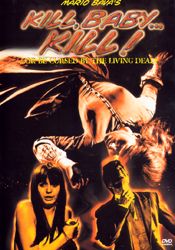
|
KILL, BABY ... KILL! REVIEW BY DEREK HILL
In a Transylvanian village, a number of villagers have ended up horribly murdered, supposedly committed as retribution for a young girl who bled to death while callous villagers feasted within sight of her, unwilling or unable to save her from her grisly fate. Summoned to the village by the local police, Dr. Eswai (Giacomo Rossi-Stuart) and his assistant Monica (Erica Blanc) begin to investigate the mysterious deaths and slowly uncover the stranglehold of occultism and terror which has plagued the villagers since the little girl’s tragic death.
The film contains many highlights and instances of dark power – the opening moments wherein we hear the blood-curdling cries of a woman as she flees her home across a field and ultimately to her doom; the silhouette of men rushing a coffin across a barren field to a graveyard, the sun slowly setting behind them; the visages of two village men as they stare at Dr. Eswai through the inn’s frosted window, their faces seemingly wraith-like and frozen; the ghost of the young girl swinging on her swing above the gravestones, her sick ebullient laughter echoing through the calm of night; Dr. Eswai’s first encounter with the little girl as she bounces her ball within the halls of the villa where the Baroness Graps spends her days and nights lost in haunted memories of what will never be again. These images and moments carry the weight of countless gothic cliches, yet they somehow feel alive and potent again through Bava’s lens. And all of it punctuated with Carlo Rustichelli’s magnificent score, which includes a small sampling from his music for Bava’s 1963 film, Whip and the Body. Kill, Baby . . . Kill! may lack much of Bava’s overt fetishism and penchant for stylized death-eroticism, but his insight into the good/evil dichotomy and how easily they can be transposed is handled with skill and relish for the material. Never again would Bava accomplish this feat as masterfully as he does here, nor would he ever display such feral delight in all that the realm of the gothic horror film could offer. Unlike the other Bava films issued by VCI, their DVD of Kill, Baby . . . Kill! is a no frills affair. The picture has been cleaned up as well as possible, though it still looks a shambles in spots. But it does look better than it has in the past on video. Three trailers for other VCI releases are also on the disc, as well as bio of the director.
Kill, Baby ... Kill! is now available on DVD from VCI Entertainment. Suggested retail price: $24.99. Kill, Baby ... Kill! is also available packaged with Blood and Black Lace and The Whip and the Body as the "Mario Bava Box Set." Suggested retail price: $59.99. For more information, check out the VCI Entertainment Web site.
|
 After directing the science-fiction/horror film Planet of the Vampires (1966) and the ill-fated Dr. Goldfoot & the Girl Bombs (1966), Mario Bava made one of his best efforts and what is arguably one of the most effective and chilling supernatural gothic horror films of all time, Kill, Baby . . . Kill! (1966). It has influenced Federico Fellini’s "Toby Dammit" sequence in the anthology film Spirits of the Dead (1967), Martin Scorsese’s The Last Temptation of Christ (1988) (the Archangel who offers Willem Dafoe a second chance at life, instead of dying on the cross, comes in the guise of a little girl) and David Lynch in Twin Peaks: Fire Walk with Me (1991), wherein much of that film’s sound design and Agent Cooper’s investigation into the town’s underbelly mirror or make direct quotes from Bava’s film. Kill, Baby . . . Kill! creates such a palpable mood of dread and oppression in its first few minutes and so effectively sustains the momentum until the last frame that it is easy to see why it has cast such a quiet legacy on other filmmakers.
After directing the science-fiction/horror film Planet of the Vampires (1966) and the ill-fated Dr. Goldfoot & the Girl Bombs (1966), Mario Bava made one of his best efforts and what is arguably one of the most effective and chilling supernatural gothic horror films of all time, Kill, Baby . . . Kill! (1966). It has influenced Federico Fellini’s "Toby Dammit" sequence in the anthology film Spirits of the Dead (1967), Martin Scorsese’s The Last Temptation of Christ (1988) (the Archangel who offers Willem Dafoe a second chance at life, instead of dying on the cross, comes in the guise of a little girl) and David Lynch in Twin Peaks: Fire Walk with Me (1991), wherein much of that film’s sound design and Agent Cooper’s investigation into the town’s underbelly mirror or make direct quotes from Bava’s film. Kill, Baby . . . Kill! creates such a palpable mood of dread and oppression in its first few minutes and so effectively sustains the momentum until the last frame that it is easy to see why it has cast such a quiet legacy on other filmmakers.

